1997 Yamaha Outboard 200 What Kind Gear Oil
An engine is nothing without the oil to lubricate its many parts and components. In developing its oil, Yamaha considers oil to be a genuine "liquid engine component," and has gained considerable knowledge and expertise through its many years of inquiry since its founding into the relationship between oil and mechanical components.
At Yamaha, in that location is no single department in charge of oil. Rather, oil development is carried out by engineers in charge of developing and building our engines. This series of manufactures will cover Yamaha's engineering and craftsmanship (Monozukuri) in the field of motor oil, ranging from the company's history of developing Genuine Yamaha oil to how high-functioning Yamalube oils are adult today.
- Vol.i
Oil and Mechanical Components Developed Simultaneously - Vol.2
Homemade Blends - Vol.3
Creating Oil for the VMAX with an XS250 Engine - Vol.4
Harsher Apply than a Racebike: Delivery Bikes in the Summer - Vol.v
Oil is a Field of study of Chemistry - Vol.half dozen
Keeping Real-World Use at the Forefront
The Legacy of Yamaha Oil
Told past the Engineers Themselves
Vol.i
Oil and Mechanical Components Adult Simultaneously
Why It'southward Called a "Liquid Engine Component"
Visually, oil for motorcycles and oil for cars don't look very unlike, but a major distinction between the 2 is that motorbike oil must fulfill a greater number of roles. Car engine oil primarily serves to lubricate and seal the engine, and parts like the manual and differential are separate and accept their ain lubrication systems. But as motorcycle engines must exist smaller out of necessity, the clutch and manual are designed every bit a unmarried unit with the engine, significant that a single type of oil has to cover the functions for all of them.
The engine needs things like lubrication, sealing, cooling, cleaning and rust prevention; the clutch needs the right corporeality of viscosity to work well; the transmission needs a buffer to cushion the touch of the gears meshing. In other words, each requires the oil to do something different. In normal running conditions, the oil makes a full apportionment of the engine in a footling less than 10 seconds and performs many functions in that time.
Merely Yamaha'south engines are non limited to only motorcycles and are constitute in machines frequently used in very specific environments, like outboard motors, snowmobiles and ATVs. Just as engine components and mechanisms are developed and optimized for the rigors of hard use and tough environments, the oil is also developed aslope the engine it volition be used in. This is the reason oil is considered a liquid engine component by Yamaha.
The History of Genuine Yamaha Oil Evolution
At that place is one piece of technology that symbolizes Yamaha'south history of developing its oil and mechanical parts alongside each other – the "Autolube" pump. Developed in 1963, information technology was the starting time device of its kind in the earth. At the time, 2-stroke engines used oil mixed into gasoline ahead of fourth dimension according to the correct oil-to-gasoline ratios for lubrication. Nevertheless, with the creation of the Autolube pump, all that was needed was to put the oil into a dissever oil tank, doing abroad with the need for pre-mixing the oil with the fuel for lubrication. The convenience this brought was praised by riders the world over.
Merely those weren't the just benefits of a divide system for oil lubrication. Designing the Autolube pump to work in conjunction with the throttle wire made it possible to inject oil into the gasoline at the correct mixture ratios for however the engine was running. This non only allowed the engine to perform at its best, but also contributed to reducing the amount of white smoke emitted from the exhaust also as reducing the corporeality of oil deposits stuck to the muffler.
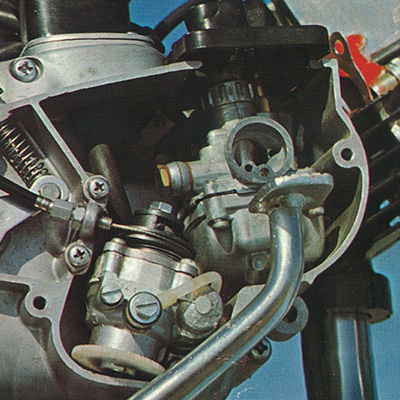
The Autolube pump was fitted with a plunger pump.
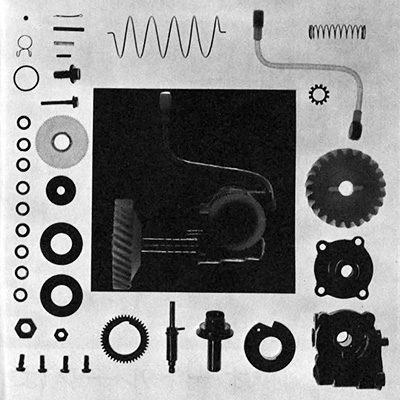
The Autolube pump had a simple structure.
The catalyst for developing the Autolube organisation was a racebike for the Road Racing Earth Title Thou Prix. Yamaha began participating full-time in GPs in 1961 at the Grand Prix of France, simply had actually already been entering other races with machines equipped with dissever automated oil injection systems and had been gathering data. Yamaha'due south engineers for production models took a hint from the forced oil lubrication pump being used on Yamaha GP machines of the time to develop the Autolube system using a plunger pump. The YA-half dozen released in 1964 became the first production motorcycle to feature an Autolube arrangement.
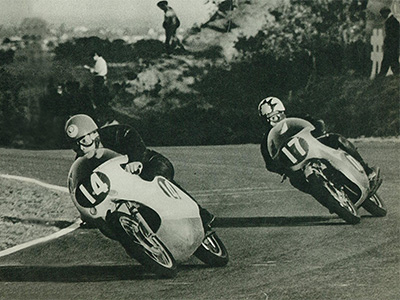
The 250cc racebike that contested the Suzuka circular of the 1962 All Japan Road Race Championship was fitted with the automatic lubrication pump.
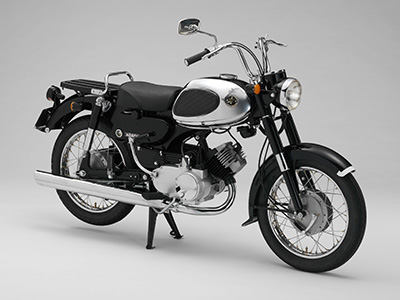
The YA-6 was the get-go production model to adopt the Autolube system.
While the arrangement was being adult, another effort was underway to produce an oil that would help the Autolube system function more efficiently. To ensure strong oil film retentivity, a low caste of combustion residuum, good detergency, good fluidity at low temperatures and more, Yamaha began testing 2-stroke engine oil available on the market at the time forth with experimental oils from petroleum refineries. The goal was to evaluate their chapters for preventing engine seizure, inhibiting wear and friction, carbon residue build-upwards, bottleneck of the frazzle ports, their effects on the piston rings, burden on the spark plugs and more. The procedure included both bench tests in the workshop and real-world tests on the road, and the result was the arrangement-specific Yamaha Autolube Oil. The work from this fourth dimension thus became the starting indicate for hereafter development of Genuine Yamaha oil.
Vol.2
Bootleg Blends
An Engine Tester Creates Genuine Yamaha Oil
At Yamaha, the engineers constantly working on the mechanical aspects of the engine are the ones that codify the oil information technology will eventually use. This approach started in the 1970s, when Yamaha products began being exported to numerous overseas markets, the number of model variations in the lineup was growing, and engines were steadily achieving higher and higher operation.
In the midst of this, it became a pressing matter to create Yamaha-brand engine oils with an eye on what the hereafter held for the industry besides as allowing customers to relish their motorcycling lifestyles with greater peace of heed. At the time, there were no uniform visitor standards for evaluating engine oil and the master method for evaluation was running the engines on a test bench. Information technology was laborious and fourth dimension-consuming work. It was around that fourth dimension that a newly hired engineer was assigned to Yamaha's Engine Testing Grouping — Yoshinobu Yashiro.
Employees involved in engine development generally come from mechanical engineering backgrounds, merely Yashiro was a somewhat singular hire equally he specialized in chemical engineering. Shortly afterwards joining the company, his superiors told him, "Since you're a chemistry guy, make sure you also take a good await at the oil." So alongside his regular engine development work, he began research into engine oil on his ain. Analyzing the oil on a molecular level to determine its makeup certainly was the right territory for a pharmacist.
Yashiro's first task was to put the 2-stroke 125cc engine of the A7 on the test bench and use it to analyze the engine oil normally used at the time. But the focus of this exercise was not but on the oil itself. If a problem occurred with the engine, it was non always clear whether the cause was the oil or the engine components themselves. If that could be properly identified, it would lead to more precise engine and oil evolution. Yashiro also conducted experiments past altering the piston and cylinder specifications and checking the results. This was in order to make proper observations about everything involved as an engine development engineer.
He so moved on to experiments and analysis using gas chromatography. This method vaporizes the oil, turning it into gas grade. The components inside the gas are so separated, allowing one to mensurate their individual density and thus understand the makeup of the oil. Yashiro would add one drib of oil to the gas chromatograph and come up back to check the result during dejeuner or a short break before adding another drop of oil. Keeping up this rather tedious work is what enabled him to see what the oil was actually fabricated of. However, the results that emerged were not what he was aiming for.
After trying several kinds of methods for analyzing oil, Yashiro finally arrived at thermal assay. Past using a thermal analyzer, yous can determine the oil's limerick past examining its response to heat. Past verifying the components of the oil and their molecular weights based on the corporeality of free energy, etc., released during oxidation, it became possible to gauge the backdrop of the base oil and its additives.
This in turn made it possible to limited the oil's bones functioning with numbers. Cross-referencing that with the engine functioning they were looking for, Yashiro could get a general idea of what course of base of operations oil and what alloy of additives would likely work best. Once it was possible to make conjectures in this way, Yamaha's path to more efficient oil development was opened.

The 1968 A7'due south engine was used in the experiments to develop Genuine Yamaha oil.
The Nativity of Autolube Super
As a chemical engineer, Yashiro badly wanted to know the makeup of the oils he was studying, but at the time, oil manufacturers did not disembalm that information. Information technology was like there was an invisible wall betwixt oil manufacturers and motorcycle manufacturers formed by an underlying doubt that neither could understand the other on a professional person level. Simply there is an interesting story backside how this wall eventually came down.
Now able to telephone call on his own cognition and information from his extensive studies about oil limerick and how oil worked in an engine, Yashiro caused a base oil and additives to work with. He then blended them himself into an experimental oil that met his performance requirements. He put four liters of it into a can and hand-delivered it to the oil manufacturer along with a paper clearly describing its composition and effects. His request was simple: "Please produce an oil that surpasses this 1."
With 2-stroke engines, oil goes from the oil tank to the oil pump, is mixed with gasoline then enters the combustion chamber. Having lubricated the engine, it exits out of the exhaust pipe forth with exhaust gases. Without knowing the ins-and-outs of how the engine works and an understanding of things like piston seizure, ring scuffing, exhaust fume, intake port and exhaust blockage, and starting the engine in cold conditions, it is impossible to develop a good engine oil.
Thanks to his noesis and expertise about engines likewise as oil, Yashiro was able to create his own blend of engine oil. After information technology became clear to the oil manufacturers that Yamaha understood oil well, they eventually began to disclose information about the composition of their oils and more than, and Yamaha engine development grew in both precision and efficiency.
The oil that came about from this story was Autolube Super, and information technology won long-lasting praise from the market place. Its wide range of compatibility meant information technology could be used in anything from scooters to supersport motorcycles, and it had the added benefits of reducing exhaust smoke and bringing better engine starts in cold weather. Autolube Super later evolved into its R and RS versions, and is withal on sale today.
It could exist said that the know-how that has been passed down to the current day for evaluating 18-carat Yamaha oil was brought about by the development of Autolube Super. Starting time, assess an oil'due south composition and then quantify and evaluate its functioning as a Genuine Yamaha oil across aspects like viscosity and vaporizability, its ability to reduce friction, its shear stability and susceptibility to foaming. Doing this not only enabled more efficient oil development just also carried the process over from motorcycles to developing Yamaha oil for outboard motors, snowmobiles, ATVs and other products. Every bit a liquid engine component, Yamaha engine oils are the way to bring out 100% of a Yamaha engine's performance.
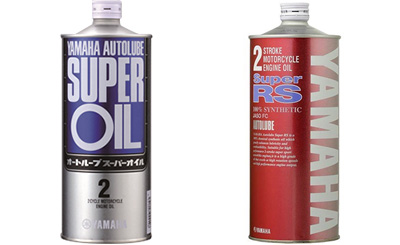
Autolube Super and Autolube Super RS
are notwithstanding on sale today.
Vol. 3
Creating Oil for the VMAX with an XS250 Engine
The Road to Genuine Yamaha 4-Stroke Oil
Yamaha's specialty had long been two-stroke sport bikes, just with the launch of the XS-one in 1970, Yamaha began to introduce iv-stroke models one after some other. However, in the decade between then and 1980s, at that place still was no company standard for evaluating Yamaha motor oil, so merely every bit it had been with 2-stroke oils, discussion began to regularly take place regarding the development of Yamaha iv-stroke oil. The first matter the engine development teams did was closely analyze the 4-stroke auto engine oils available on the market to attempt to make up one's mind what type would be all-time suited to Yamaha machines.
Around that time, Yamaha oil legend Yoshinobu Yashiro (introduced in Vol. ane and Vol. 2) had his hands completely full betwixt developing 2-stroke engines also as 18-carat Yamaha oil. It was then that Tohru Miura, another engineer with a chemistry background, was assigned to the Engine Testing Group. He himself had requested engine development duties: "I'k tired of chemistry; I want to work on the machines."
Having somebody like Miura join the team must have been a godsend to the extremely busy Yashiro. Miura, like Yashiro, was given the job of primarily working on engine evolution but also conducting research into oil on the side. Yamaha does non accept engineers solely devoted to oil piece of work. To achieve excellent production reliability as well as boost performance, engineers that understand engines and oil with the same levels of expertise are needed.
What Yamaha placed particular importance on when developing its ain 4-stroke motor oil was testing with real engines and machines. After all, y'all tin't fully understand oil without running information technology through the engine offset—that'due south how Yamaha approaches oil development.
At the time, Miura was involved with developing the engine for the kickoff-generation VMAX. Equally Yamaha was quickly moving towards sport bikes with more engine deportation and higher power like with the VMAX, he was trying determine what kind of engine oil would best fit such motorcycles. Since there was no way—and no time—to run an oil exam on an engine still under development, Miura'due south solution was to use an XS250 engine on a test bench. Could an air-cooled 250cc twin engine really take the place of a ane,200cc V4 DOHC engine—with V-Boost, no less—for testing?

The XS250'due south engine was used for oil testing.

A pamphlet for the air-cooled XS250 when it was released
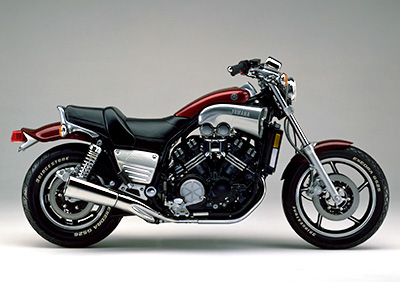
The one,200cc VMAX was a wheel exemplifying the 1980s.
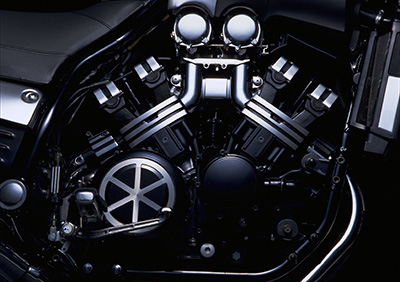
The VMAX's liquid-cooled V4 was the world's about powerful production motorcycle engine when it was built
As a matter of fact, air-cooled, small-scale-deportation engines are really very hard on oil. The ultimate goal of engine oil is to prevent the engine from breaking, so Miura wrung the engine out to its absolute limit while examining in great item the oil's performance, such as lubrication, cooling properties, detergency and the presence of whatever air bubbling, as well as things like the condition of the metallic effectually the camshaft and crankshaft bearings. In this fashion, Miura took advantage of the expertise gained in the 2-stroke era and built on it with further R&D, afterwards resulting in today'due south Yamalube.
Boosting Performance with Oil
Today, Yamaha products are run on the land, in the water and in the air in areas all over the world. The quality standards for Yamalube—the Genuine Yamaha oil used in everything from motorcycles and outboard motors to snowmobiles and ATVs—were established in the 1980s. To match the rapid progress beingness made in engine technology at the time, Yamaha engaged in a multifariousness of efforts to try and innovate with motor oil as well.
The standard choice for Yamaha motorcycle engine oil today in Japan is Yamalube Sports, only its origins can be traced back to Yamalube Extra Z, an oil developed in the early part of the 1980s. In the history of Genuine Yamaha 4-stroke oil evolution, Extra Z was epoch-making in its significance. It all began with an encounter with a base oil created by one oil company. The molecular makeup of the mineral oil had been chemically altered with a method chosen hydrotreatment. While it was nonetheless a mineral oil, it had viscosity characteristics on par with today's semi-synthetic oils—a revolutionary achievement.
When Miura got word of this, he speedily set a meeting with the oil producer and requested that they employ the method to produce a Genuine Yamaha oil. The request was accepted and this eventually led to the evolution of Yamalube Actress Z. Incidentally, Yamaha was among the primeval motorcycle manufacturers to commercialize an engine oil made with hydrotreatment.
The main job of engine oil is to go on the engine from breaking downwardly, but Yamaha did not finish there. How much more than performance can nosotros get from oil alone? In essence, Yamaha began to view oil in the aforementioned manner every bit designing an engine role or mechanism.
In 1985, the FZ250 Phazer debuted with a four-cylinder engine that could rev upwardly to 16,000 rpm and it quickly grabbed the market's attending. The pattern precision and composure of the engine was impressive, simply so also was the challenge to see if more horsepower could be extracted with oil. The engine evolution team carried out tests using molybdenum as an additive.

Yamalube Sports inherits the performance-boosting qualities of Yamalube EFERO FX.
What Miura and his team prepare out to tackle next was to develop an oil with all the attributes ideal for a motorcycle. The project put worries nigh cost and expenses aside, allowing the engineers to do all they possibly could.
From their firm decision and hard work came Yamalube EFERO R, a full-synthetic oil with a low, 5W-20 viscosity. Its performance was on par with full-on racing oil and the model the team had in mind was the FZR750R, a race homologation model also known as the OW01. During the height of the boom in racebike replicas in Japan, EFERO R eventually evolved into Yamalube EFERO RS, a blend of oil also usable in production racing.
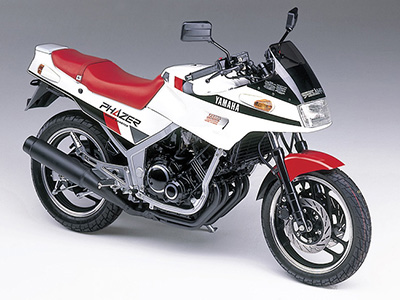
The FZR250 Phazer'south engine could rev to 16,000 rpm, something that won it much attention.
Molybdenum is so effective at reducing friction resistance that but adding it to the oil raises the idle rpm of the engine. Just if friction resistance is reduced as well much, information technology tin can upshot in side furnishings similar clutch slippage. So, the team optimized the blend of the additives while coming upwards with creative solutions for the engine parts and mechanisms to bargain with such furnishings. The oil that came almost every bit a effect was Yamalube EFERO FX.

The FZR750R (OW01) was designed and engineered to run into technical requirements in order to be used as a racebike, i.e., race homologation.
However, as much equally the FZR Series models were referred to every bit replicas of racebikes, Yamaha was insistent while designing them that they too exist friendly, easy-to-ride machines. In the same way, the oil needed to cover a broad spectrum of functioning that included the average rider using their bike for everyday fun. All the expertise gained through these endeavors has been passed down to the Yamalube products in use today all around the world.
Vol. four
Harsher Use than a Racebike: Delivery Bikes in the Summer
Misunderstandings About Engine Oil
In interviewing Yoshinobu Yashiro, a legendary figure in the development of Yamaha engine oil, there was i moment when he showed a fleck of lingering frustration. "Many people take misunderstandings nearly engine oils," he said. "The prevailing thought is that y'all desire a high-end oil for a supercar and a standard, run-of-the-mill oil for a 660cc Japanese kei compact machine. But, which car do you think puts more stress on and demands more than performance from the engine oil?"
A supercar's big and powerful engine merely needs to run at about ii,000 rpm to cruise at 100 km/h. On the other hand, a kei car has to maintain something around six,000 rpm to exercise the same. "The same misunderstanding exists with motorcycles as well," Yashiro continues. "Many retrieve the oil for a supersport bike will exist high-performing while the oil for a 50cc scooter won't be."
Yashiro explains that oils for supersport models are indeed specifically blended with a carefully formulated mix of additives aimed at boosting operation. Withal, he then asks, "What kind of wheel practise you think places the toughest demands on engine oil?"
His answer wasn't what most people would wait: "Information technology's the small bikes post offices use for delivering the post or the ones insurance salespeople use for making their rounds in the midsummer oestrus. Because they accept trivial power, the throttle is kept fully open nigh of the time in one case they get going, and sometimes they are kept idling as the rider talks at length with a customer. The estrus is scorching under the summer sunday and there is no wind, not to mention it'south an air-cooled engine! Nothing is tougher on oil than these kinds of weather."

The Yamaha Town Mate was congenital to withstand the toughest of use conditions.
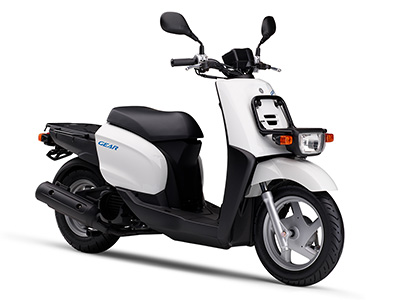
The Gear's liquid-cooled engine reduces the demands on its engine oil.
Of course, a supersport model existence run at full tilt during a trackday or in product racing presents some very tough atmospheric condition for oil, just these machines are typically liquid-cooled and fitted with other parts to keep temperatures in check like an oil libation and piston cooling system. This keeps cylinder temperatures at effectually 140 °C.
In dissimilarity, the cylinder temperature with small-deportation air-cooled engines can reach to 230–240 °C and oil temperature can exceed 120 °C, which means from the oil's standpoint, a supersport cycle is a much more welcome surround. As well, the engines in outboard motors identify as stringent demands on the oil. In one case out on the water, the engine is often kept running at full throttle for hours on end, and the smaller the engine'due south displacement, the tougher things go for the oil.

Small-displacement outboard motors are exposed to incredibly harsh use environments.
From the company's primeval years, Yamaha Motor devoted itself to developing 18-carat Yamaha engine oil for its small-deportation, high-output ii-stroke engines. I of the outset challenges engineers had to tackle was how to use oil to farther preclude piston seizures. The lesson they learned was to use the best possible base oil.
With today'south Yamalube oils, the level of quality is essentially the same for our supersport and 50cc bike oils; the difference lies in the "tuning" of each oil to fit the model's intended use. In emphatic terms, putting a standard-course Yamalube oil in a YZF-R1 volition non cause any particular trouble. However, if you desire to bring out the full potential of the automobile, a loftier-performance oil similar our RS4GP is the all-time selection.
This is because our Yamalube oils are "liquid engine components" designed specifically with the individual product's performance and uses in mind.
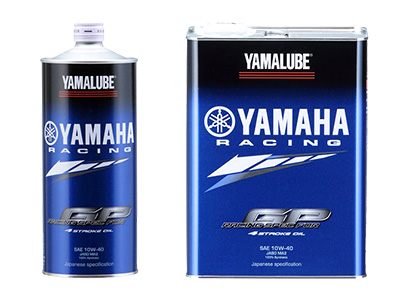
The highest class of Yamalube oil available: RS4GP
Oil Myths
Today, at that place are all kinds of high-end, loftier-performance engine oils on the market that leverage the full resources of their respective oil companies. It is besides but natural for riders to want an oil that adds to their machine's functioning—it's i of the joys of being a motorcyclist, after all.
However, an expensive oil doesn't always mean it'south the best oil. From the standpoint of an engine builder, zero is better than an oil that brings out the full performance potential of the final machine.
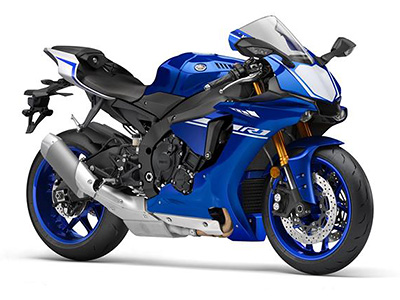
The YZF-R1'southward engine was designed to take maximum advantage of the oil information technology uses.
Yamaha strongly recommends using Yamalube oils for Yamaha products. Because they are all created by the very engineers designing the engines, nosotros believe these oils offer the best compatibility with the engine'south diverse parts and mechanisms. In fact, Yamaha's engine development process itself begins with selecting a "development oil" created according to our special standards, and and then the engine'due south specifications are decided.
If choosing this development oil marks the kickoff of creating the oil for the engine, the finish line is evaluation and approving equally a Genuine Yamaha oil by the Oil SIG (Special Interest Grouping) at Yamaha Motor headquarters.
All Genuine Yamaha oils manufactured around the globe today run into the high standards set up by Yamaha headquarters, but the terminal decision of whether or not they can be sold under the Yamalube make name is made past the Oil SIG. As a company developing and manufacturing a diverse portfolio of products for the world'south markets—from motorcycles and outboard motors to snowmobiles, ATVs and portable generators—how does Yamaha certify an oil every bit existence suitable for a specific product?
It but isn't feasible to assess every submitted oil with an engine examination bench. Instead, what comes into play is the vast stock of data accumulated over decades of in-house oil development. With this information, today's Oil SIG is able to approximate everything almost the oil and make evaluations from the technical documents compiling information like the type of base oil, the additives used and the alloy ratios.
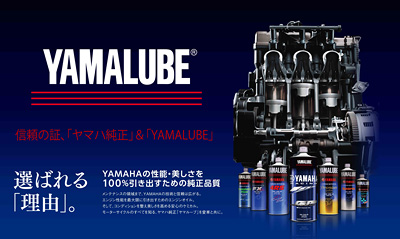
All of the Yamalube oils sold in Japan (motorcycle oils shown) are also evaluated and approved by Yamaha's Oil SIG.
"It isn't a product if it isn't world class." These are the often-spoken words of Yamaha Motor's founding president, Genichi Kawakami, and they are a guiding principle behind what makes Yamaha products found all over the world inextricably linked to the skillful reputation Yamaha enjoys today. Though seldom seen, Yamalube oil is difficult at work within each and every one of those engines, helping them bring users the best possible performance.
Vol. 5
Oil is a Subject of Chemical science
Yamaha Has No Oil Development Division
Where exactly does Yamaha develop Yamalube oil? As mentioned earlier in this serial of manufactures, Yamaha does not have a department specifically devoted to oil evolution. From the 1960s when the Autolube pump and Autolube oil was developed to the nowadays 24-hour interval, the engineers in charge of engine testing take carried out oil evolution alongside their principal engine development duties. However, what is somewhat unique is the fact that these engineers' backgrounds are not in mechanical engineering, just chemical applied science. It's incommunicable to empathise engine oil and its requirements without understanding the mechanisms of the machine itself, and it'due south vital to be able to imagine the oil as it fills the endless gaps between the respective mechanisms of the engine, clutch and manual while they operate at incredible speeds.
There are largely two types of lubrication: fluid motion picture (hydrodynamic) lubrication and boundary lubrication. With cars, the engine, clutch and transmission are split from each other, and each requires its own specific oil. But in motorcycles, those are all continued every bit one unit of measurement, so a single oil must lubricate everything. For example, while the pistons and cylinders rely on fluid motion picture lubrication and the type of base of operations oil is central, transmission gear appointment relies on boundary lubrication, so the blend of oil additives is key. Then, at that place is elasto-hydrodynamic lubrication for the cam and camshafts...and and so on.
Then, the oil characteristics needed for each mechanism of the power unit differ. As such, if engineers with intimate knowledge of (1) how an engine office moves, (two) the blazon of metal the part is made of and (3) the chemical properties of oil itself are the ones creating the oil for the engine, you could say that it's the quickest shortcut to making progress.
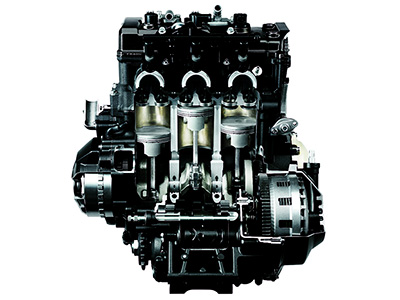
The engine, clutch and transmission are all a single unit with a motorcycle engine (MT-09 engine pictured).
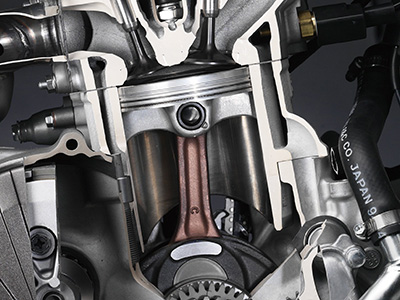
The inner walls of an engine cylinder and a piston use fluid film lubrication (YZ450F engine pictured).
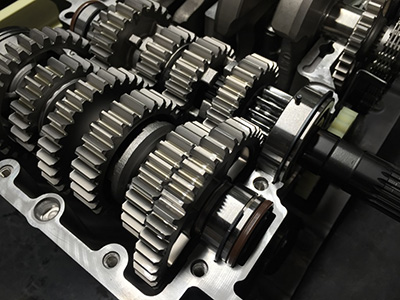
A motorbike manual and its many gears use boundary lubrication.
Back in the 1970s when Yoshinobu Yashiro was working by himself on developing standards for 18-carat Yamaha motor oil, he realized that oil manufacturers likely did non have enough knowledge and agreement of the effectively workings of engines. Merely that was understandable; to a chemical engineer at an oil refinery, pistons and gears are a completely dissimilar world. That realization set Yashiro on the path to creating Yamaha'south own standards for motor oil. His arroyo was logical and straightforward: acquire to understand what I don't understand already. His path upwards this proverbial mountain had 2 dissimilar starting points—mechanical and chemic—but the goal that lay at the superlative was the same.
Intriguing Because Both the Mechanisms and the Oil are Unknowns
Yamalube is created past engineers who sympathise both machinery and chemistry. The path that Yoshinobu Yashiro and Tohru Miura paved is at present in the hands of a new generation. Another grouping of new engineers with chemical engineering backgrounds has joined Yamaha's Engine Evolution Partition. "The reason Yamaha doesn't have an oil development division is that if we did, everybody would await at things primarily from an oil development perspective," says Miura. "We create engines, not motor oil, so our job is to figure out the best oil for the engines nosotros make."
We tend to think that with all the progress made in the many fields of science and technology, anything and everything in the globe is understandable with analysis. However, Yamaha believes that real technological progress is found in the areas where this is not the instance. In the past, oil was not well understood. Until the 1960s, the oil selected by a handful of experts was considered adept oil, and their educated guesses produced positive results again and once more. Still, those oils were called with qualitative inquiry, so carrying over those advances to other product categories was no easy chore.
Yashiro analyzed everything related to oil and the engine, and quantified his findings. This opened the path for developing Genuine Yamaha motor oil, only things didn't terminate in that location. In the 1980s at the Small-scale Engine Technology Conference (SETC) held in Melbourne, Australia, Yashiro presented a newspaper on the relationship betwixt engines and oil using thermal analysis, and the results of the paper were widely shared throughout the technology community. Yashiro stated that the reason he did it was because nobody was interested in the topic at the fourth dimension, simply 1 could say information technology was to spread to a wider audition the roles that oil has in improving engine reliability.
In Japan, the "MA" and "MB" markings seen on motor oil indicate the standards information technology meets and are from the Japanese Machine Standard Organization (JASO). These motorcycle oil standards were established in 1994 and are unique to the Japanese market. Though Japan was already a global leader in motorcycle manufacture and export so, there were still no standards for motorcycle oil quality or a divers method for testing them. Until they were created, the standards used included those from the American Petroleum Industry (API), the International Lubricant Standardization and Approval Commission (ILSAC) and the Clan of Constructors of European Automobiles (ACEA), merely all of these were based on motor oils for cars.
Since motorcycles take the engine, clutch and manual all every bit a single unit, there was a need to create standards specifically for them, and Japan'southward four major motorcycle manufacturers got together and laid out these standards. At the time, automobile motor oils were starting to include special additives designed to ameliorate fuel economy, but these could actually cause problems when brought over to motorcycles.
Yamaha took on a very proactive office in creating the JASO standards for motorcycle oils, contributing information like its oil testing methodology and evaluation criteria—cadre components for establishing such standards. Although the manufacturers involved were all competing with each other, everyone's goal was the aforementioned: create an environment in which motorcycles tin can be enjoyed with greater peace of mind by improving reliability, lessening the impact on the surround and more. However, standards beingness put in identify does not necessarily mean that all oil is created equal.
Yamalube is a liquid engine component. As this component plays an essential role in improving the reliability of Yamaha products the world over—be it on the land, h2o or snow—we continue to carry out independent R&D to stay in step with the constantly higher-performing mechanisms and technologies of today. With applied science, in that location is no "terminate line." In our quest to find new uses and to create new value for our customers, there will only be more than and more things that we don't nevertheless understand. But at Yamaha, breaking through and making those unknowns our expertise is who we are.

The JASO MA2 engine oil standards listed
Vol. half dozen
Keeping Real-World Employ at the Forefront
For Unrivaled Reliability: Genuine Yamaha Oil for Marine Engines
With marine engines and engines used on land, there are naturally major differences in how they are used. As marine engines are for use on the water, rust prevention is one obvious concern, but the biggest is the load these engines are subjected to; information technology is mutual do to run marine engines at full throttle for hours on end. From large fishing boats out to catch marlin to tiny skiffs equipped with a single sub-10 horsepower outboard motor, the uses and environments marine engines are exposed to are severe.
Since releasing the 2-stroke P-7 outboard motor in 1960, Yamaha outboards found apply non but in sport angling, but besides in commercial fishing worldwide, and the number of owners chop-chop grew. As this happened, the part of engine oil became an even greater point of focus when working to ameliorate engine reliability. In the 1980s, Yamaha began equipping its outboards with Autolube pumps, which had won a strong reputation for reliability in the motorcycle manufacture. The Autolube system always delivered the correct corporeality of oil to mix with the fuel, and since fuel quality would vary greatly by market place region, this machinery non only protected the engine but also extracted maximum performance from the oil itself. Nonetheless, the norm at the fourth dimension was to apply any oil was locally available for sale in each country, and the concept of oil created and approved by the manufacturer of the outboard did not yet be.

The P-7 was Yamaha'southward first outboard and its engine was based on the YA-1 motorbike engine.
It was effectually and so that Yamaha engineer Takao Nagai was assigned a key function in developing marine engines. For 30-odd years and fifty-fifty to this day, he has been developing both marine engines and Genuine Yamaha oil. There was one particular incident during his career that led to his determination to pursue creating Yamaha-brand oil for marine engines. In the tardily 1980s, there were several customer complaints almost the pistons in large-displacement, loftier-power outboard engines. Furthermore, this wasn't limited to Yamaha; other manufacturers were facing similar problems with their outboards.
The engine development team had a hypothesis: "It seems like this isn't only a mechanical issue. What if the engine oil is also playing a office in this?" To test it, they gathered together several leading marine engine oils bachelor on the market and ran repeated tests with actual engines. Simply every bit had been suspected, the testing results showed that oil was 1 of the causes of the piston bug. In those days, the TC-W2® oil standard for N America put in place by the National Marine Manufacturers Association (NMMA) was the de-facto guideline for evaluating fuel economic system and eco-friendliness, and each oil company sold oil meeting the standard. However, when outboards were subjected to continuous heavy loads during Yamaha's tests, information technology became clear that the resulting rising in engine temperature could cause the piston rings to stick.
With this new knowledge, Yamaha gear up to work on developing a Genuine Yamaha oil for outboard motors as apace as possible. Running outboards at full throttle for long periods of time and stressing the engine was not something limited to large-deportation models. If anything, smaller outboards would be even more than drastically affected because of the heavy workload they are often subjected to. Yamaha'south oil not but satisfied the TC-W2® standards and the following TC-W3® standards, but the company went farther and established even stricter in-house standards for itself. By researching additive blends containing cleaning agents and more, the team completed a Genuine Yamaha oil for marine engines.
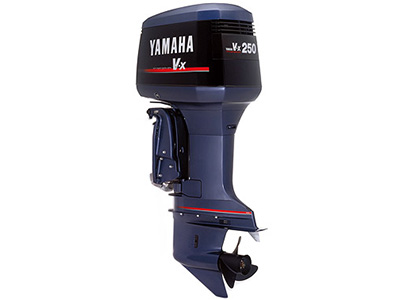
Big-deportation V-engine outboards are what led to the evolution of Genuine Yamaha oil for marine engines.
Today, the performance of an oil can now exist determined past simply examining its composition and other specifications based on the wealth of data compiled over the years. Simply before that was possible, extensive bench testing of bodily engines was critical. In the past, exam outboards would be ready up in h2o tanks and run continuously at full throttle for an unimaginably long time. They were then disassembled and engineers would check both the condition of the engine's internals and the state of the oil. This pace used to be an irreplaceable role of the development procedure. With an engine e'er in its all-time condition, it can power the boat and its coiffure out of and back to port safely. Yamaha engineers have non but the engine itself, but the lives of the people who will rely on it in mind as they work.
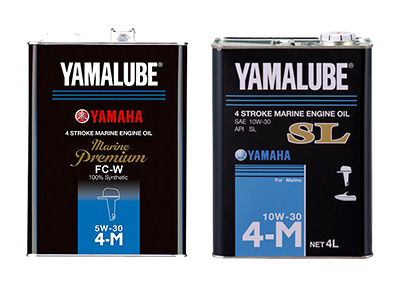
Yamalube oil for 4-stroke marine engines
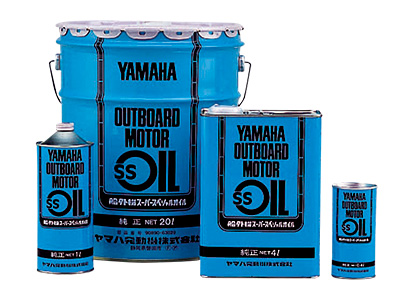
Genuine Yamaha 2-stroke outboard motor oil
18-carat Yamaha Snowmobile Oil Developed in -30°C Temperatures
Much like marine engines, the engines in snowmobiles are too directly connected to the lives of riders. Being haunted by engine problem in the middle of a deserted snowfield in below-freezing temperatures is something nobody wants to think about, let alone feel.
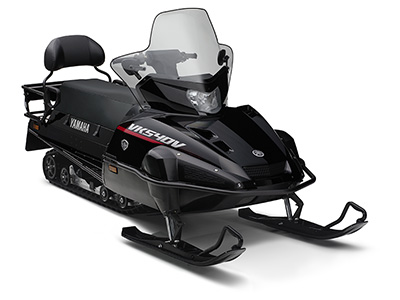
The 2-stroke VK540V is a long-seller renowned for its reliability.
Yamaha developed the SL350 as its first snowmobile. It was powered by a two-stroke 350cc 2-cylinder engine and was released on the North American market in 1968. Since snowmobiles are used in extremely common cold climates, the oil they utilize requires special qualities and characteristics, among which is the ability to fire up the engine in cold temperatures. The majority of snowmobiles today have 4-stroke engines and electrical starters, but 2-stroke engines accept recoil starters that require the rider to pull a cord to plough the crank and kickoff the engine.
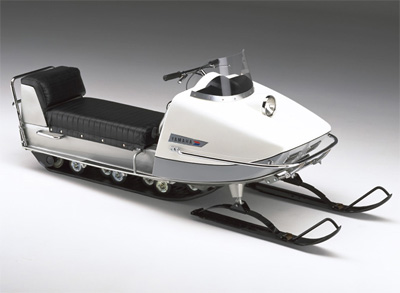
Yamaha's first snowmobile, the SL350
For example, what would happen if you put regular motorbike engine oil into a snowmobile in -30°C temperatures? The oil in the engine would behave like olive oil put in a fridge, thickening and inhibiting the creepo from turning. Then, snowmobile engine oil needs to have low viscosity, just fantabulous fluidity at low temperatures comes at the toll of reduced lubrication performance. Since snowmobiles run into a lot of resistance from the snow while underway, the throttle must be kept almost fully open for much of the time, subjecting the engine to heavy loads that can lead to engine seizure. But even if molybdenum is added to the oil to reduce frictional resistance, this causes the recoil starter'due south one-style clutch to slip.
The engineer that worked to overcome these two conflicting qualities while developing Genuine Yamaha oil was Manabu Kai. As an engine exam engineer since the 1980s to the present twenty-four hour period, Kai has viewed engines and oil from a single, unchanging perspective over his long career. As part of Yamaha's engine testing team, he regularly flew to Alaska in the eye of winter for ii months of engine tests in the frigid cold. The squad would hire a eatery airtight for the wintertime and prepare it up every bit their base of operations camp. They slept there at night and rode snowmobiles in the surrounding fields during the 24-hour interval, carrying out real-world tests that couldn't be recreated with bench testing. The bombardment of testing included engine starts, riding uphill and downhill, and over endless bumps in the trail. Kai checked and verified firsthand if the oil was doing its job properly throughout the testing, examining oil pumps, engine oil passages and more.
The method called for developing Genuine Yamaha oil for snowmobiles was to select a base oil from the data accumulated with motorcycles, and blending it with the appropriate additives. The standard for the oil's evaluation would be the engine's ability to start in common cold temperatures—a point especially of import with snowmobiles. When engines were tested in cold rooms at Yamaha Motor headquarters at -40°C temperatures, the recoil starter would often be besides heavy to pull. Otherwise, the first successful pull would be heavy, and and then on the 2d try, the string would all of a sudden become low-cal and the engine would showtime up. In that location was no logical explanation for the phenomenon, so it was through these field tests that the optimal base oil and additives were decided upon.

Yamalube Snow Oil R-FORCE yields outstanding engine starts in cold temperatures and excellent lubrication during high-load use.
In 2002, Yamaha succeeded in becoming the starting time company to transition to iv-stroke snowmobiles. At the time, the YZF-R1 flagship supersport motorbike featured the latest motorcycle engine know-how for both fuel combustion and oil technology. With an engine based on the R1's, the RX-ane four-stroke snowmobile made a sensational debut.
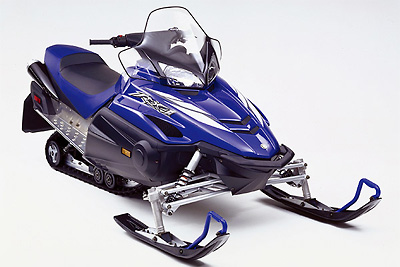
In 2002, the RX-ane set off Yamaha's transition to 4-stroke snowmobiles.
There is a unique synergy with Yamaha'southward products and its technologies. Motorbike engines, marine engines and snowmobile engines are all used in dissimilar environments, and their respective specifications and performance requirements also differ. However, the know-how and technologies Yamaha builds upwardly inside one product category inevitably becomes woven into a different category. In the same way, our knowledge and expertise with engine oil accumulated over decades of R&D is immune to product boundaries and is shared throughout our businesses. Since the requests we make to oil companies contain performance requirements laid out by our engine development divisions, they supply us with high-quality oil meeting the strictest standards. Implementing that same method on a global scale is how we create Yamalube oil for every Yamaha product.
DOWNLOAD HERE
1997 Yamaha Outboard 200 What Kind Gear Oil UPDATED
Posted by: barbarathinted1971.blogspot.com
0 comments:
Post a Comment